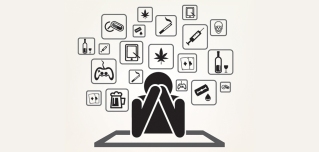A thought recently crystallized in my mind: If I want to move towards freedom from unease (aka suffering/stress/unsatisfactoriness), there’s one concept I need to definitely dispose of: “should”, or “supposed”.  In addition, I’ve also been going through a gradual process of parting with my many addictions, a process that has been going on for a few years already. I’m pretty much down to two: sugar and thinking.
In addition, I’ve also been going through a gradual process of parting with my many addictions, a process that has been going on for a few years already. I’m pretty much down to two: sugar and thinking.
You’ll see how these tie-in with each other in just a bit.
There are two key pieces of information regarding unease that the Buddha taught. The first one is from the famous Four Noble Truths, and the second from his discourse on suffering.
The two first Noble Truths, are the Truth of Unease and the Origination of Unease:
“And this, O seekers of virtue, is the Noble Truth of Suffering; that is, birth is suffering, aging is suffering, sickness is suffering, death is suffering, the suffering of meeting with the unappealing, the suffering of parting from the appealing, and pursuing but not obtaining what is desired is also suffering. In brief, the five [psycho-physical constituent] aggregates of grasping are suffering.”
“And this, O seekers of virtue, is the Noble Truth of Suffering’s Origination; that is, all that which constitutes the arising of craving, fixation on pleasure, and enthrallment with this and that. Namely, the craving of attachment, the craving for cyclic existence (saṃsāra), and the craving for separation from cyclic existence.”
~ translated by Erick Tsiknopoulos

In short, the Buddha says elsewhere, unease/suffering stems from craving. Now this craving manifests in different ways, but I increasingly recognize that it is basically the constant nag that we feel to be somewhere else, someone else, or doing something else.
Importantly, suffering – the Buddha assures us – isn’t something to be feared. It is something to be known. It is a part of our reality, and the Buddhist path is a path of looking fearlessly directly at reality, understanding it, knowing it, and thereby stopping all this craving, all this constant running around, pushing and pulling.
The second discourse I mentioned, the Dukkhata Sutta, organizes all the many different kinds of unease into 3 categories, and this is very convenient for the task of understanding suffering. These are (1) the Suffering of Suffering, (2) the Suffering of Change, and (3) All-pervasive Suffering.
The first, Suffering of Suffering includes physical and emotional pain which is inevitable, such as when we break a limb or loose a loved one, and that proverbial second arrow – our judgments and emotional reactions to that pain which greatly escalate the amount of suffering it brings with it.
The second, Suffering of Change is the stress and discomfort caused to us by the changing nature of phenomena, impermanence. Having something we love taken away or conversely, not getting something we want are types of unease caused by impermanence. Change in itself is not what causes the suffering, but our own attachment, the process of imbuing these impermanent things with a false sense of permanence. If we give this attitude up, we do not have to be afflicted by this unease. This is beautifully illustrated in this example of the eminent Thai Buddhist Master, Ajahn Chah:

“One day Ajahn Chah held up a beautiful Chinese tea cup, “To me this cup is already broken. Because I know its fate, I can enjoy it fully here and now. And when it’s gone, it’s gone.’” When we understand the truth of uncertainty and relax, we become free.”
~ version by Jack Kornfield
The third kind, All-pervasive Suffering, is that basic undertone, that ever-present buzz of dissatisfaction that accompanies every single moment. That’s the one I put my finger on, the constant wanting to change something, even if it ain’t broken, as they say. This, in fact, is the mechanism of addiction. Being itself is never enough. If only we win that prize, if only we earn X amount of money, if only we get to that next checkpoint – then we’ll be truly happy. Then we might stop feeling that unstable craving feeling.
The Buddha put a swift end to this line of reasoning. This all pervasive suffering is an innate characteristic of our deluded and misguided existence. Scratching the itch will bring momentary relief but will only make the wound deeper and deeper, as every addict knows.

The only way to address this problem is by changing our habitual patterns of trying to achieve happiness through pleasure. This can only be done by looking deeply at reality, and seeing how things are. And so, having seen that all conditioned things are completely devoid of any fixed/permanent existence, we proceed to undo the habit of living as if they are, as if we are.
If you’d like to learn methods for doing just this, we have a podcast series dedicated to this exact purpose. the Birdseye View of the Buddhist Path series is soon coming to a close, and it explores the whole path from beginning to end in very broad strokes, and provides guided meditations to help transmute this knowledge into intuition. Check out the Ordinary Mind Meditation Podcast right here: Birdseye View of the Buddhist Path.
If you enjoy the materials offered here on Bodhi&Bass, please join our Facebook community, and leave a review. This simple gesture goes a long way in helping us sustain this website, and keep offering ever more high quality materials.
May you be content and at peace.
Amituofo!

Pingback: November Newsletter: No Such Thing as a Buddhist Priest – Bodhi&Bass
Pingback: Thinking About Thinking – Bodhi&Bass